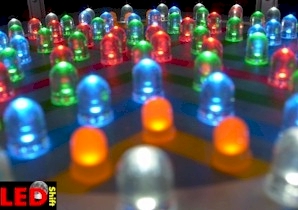 www.LED
www.LED
Luminous intensity (cd, mcd, 1cd = 1000mcd)
PLEASE NOTE!!!:
Our German sites are much more detailed then our English sites. So please switch in our Germen sites and use the language translater (top right) with 60 languages.
Luminous intensity is the radiating power of a source of light in a particular direction, weighted with the spectral sensitivity of the eye. Measuring luminous intensity in candela (English Candela) over the entire solid angle in Sterad (SR), one receives the light-current in lumens (lm).
Sometimes it is difficult to understand all the different terms what LED producer indicates such as lux, lumens, candela ore luminance.
In order to bring light into this dilemma try to imagine the following:
 The flame of a ordinary candle emits light lm in all directionss (over the whole sphere surface) into the surrounding arear, independently of the angle!
The flame of a ordinary candle emits light lm in all directionss (over the whole sphere surface) into the surrounding arear, independently of the angle!We encase now mental the candle with a sphere with a radius of 1m. The flame is placed in the center. The surface amounts of these sphere(the entire solid angles) is now 4x3.14x1² = 12.566m² and represents the highest border, thus 360° SR.
We note, the greatest possible solid angle is 12,566, according to the surface of a sphere of 4*Pi.
 We draw now on the surface an area of exactly 1m²(in practice the area would be a curved circular).If we connect now the corner points of the surface the lines includes a solid angle of 65,55°.
We draw now on the surface an area of exactly 1m²(in practice the area would be a curved circular).If we connect now the corner points of the surface the lines includes a solid angle of 65,55°.
One would have to line up now 12.566 of such segments to become a sphere again.
A LED with an angle of e.g. only 20°, possesses a SR of 0,0955 and one would have line up 132 such LEDs, like a ball together to get the full angle! (look at our table)
Where does our luminous intensity (CD) remain now?
The unit of luminous intensity results now from the quotient too lm:sr (Lumen/Steradiant).
With our example, the candle sends 12 lm into all directions in space(360°). For an angle of 65°(1sr) there is only 1 CD (12:12=1) left.
To better understanding, another example:
If we now would pencil the light-current of the candel(12 lm) by a parabol mirrors to our 1m² surface (on an angle of 65°=1sr), then our candle would have on times a luminous intensity of 12 CD!
Isotrope Sources of light (Bulbs, candle) radiates their light in all directions in space.
Anisotrope Sources of light (LEDs) radiates their light in a solid angle. In the example with the parabol mirror, we made form an anisotropic an isotropic source of light.
| Opening angle: | 180° | 90° | 65,55° | 60° | 50° | 45° | 40° | 30° | 20° | 15° | 10° | 1° |
| Parts of the sphere | 2 | 6,8 | 12,566 | 15 | 21 | 26 | 33 | 59 | 132 | 234 | 526 | 52525 |
| sr Factor | 6,28 | 1,84 | 1,00 | 0,842 | 0,589 | 0,478 | 0,379 | 0,214 | 0,0955 | 0,0538 | 0,0239 | 0,00024 |
| Öffnungswinkel: | 180° | 170° | 160° | 150° | 140° | 130° | 120° | 110° | 100° | 95° | 90° | 85° | 80° | 75° | |
| sr Faktor | 6,2832 | 5,7356 | 5,1921 | 4,6570 | 4,1342 | 3,6278 | 3,1416 | 2,6793 | 2,2444 | 2,0383 | 1,8403 | 1,6507 | 1,4700 | 1,2984 | |
| Öffnungswinkel: | 70° | 65,55° | 60° | 55° | 50° | 45° | 40° | 35° | 30° | 25° | 20° | 15° | 10° | 5° | 1° |
| sr Faktor | 1,1363 | 1,0003 | 0,8418 | 0,7099 | 0,5887 | 0,4783 | 0,3789 | 0,2908 | 0,2141 | 0,1489 | 0,0955 | 0,0538 | 0,0239 | 0,0060 | 0,00024 |
| AGB Ledshift | LED Function | LED Producer | LED Distributor | LED Events | LED Company Entry | LEDS | Sitemap | Contact | |
|
|
© Markus Kottas, Heldenberg Ltd.2018